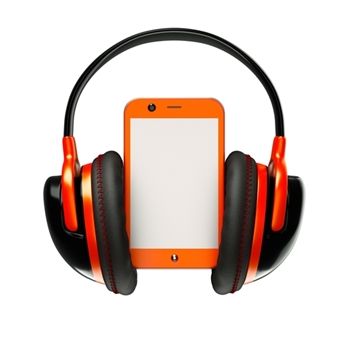 The human voice can convey much more meaning through tone and inflection than the printed word ever can. It’s why millions of Americans sat, fixated, during the Golden Age of Radio – listening to everything from adventure, comedy and drama to classical music concerts, news and farm reports.
The human voice can convey much more meaning through tone and inflection than the printed word ever can. It’s why millions of Americans sat, fixated, during the Golden Age of Radio – listening to everything from adventure, comedy and drama to classical music concerts, news and farm reports.
As broadcast radio gave way to television, television to cable and cable relinquishing to the internet of everything, it comes as no surprise to content marketers that, spurred by technological advancements, broadcast radio has come full circle with podcasting and represents a new platform for storytelling.
The average podcast listener stays connected for 22 minutes on average (Sticher). This is one of the reasons why including podcasting as part of a long form content marketing strategy is so powerful. You have the opportunity to build a deep, rich relationship with your target audience.
Research agrees that podcasting is hitting it’s stride. Podcasting has hit mainstream America, according to Edison Research. [PDF] Online radio is being consumed by millions of Americans on a regular basis with nearly half of all Americans surveyed familiar with the term “podcasting.” Stats on podcasting you may be interested in:
- 32 million people listened to a podcast in the last month
- More than ¼ of weekly podcast users consume 6 or more podcasts a week
- 6% of Americans over the age of 12 listened exclusively to online radio in the past week.
- Video podcast listeners = 22%; audio podcast listeners = 27%
- 44% of smartphone users have listened to online radio; 18% listen daily
- 29% have used iPod/MP3 players for in-car media consumption
- 12 hours/week on average people report time spent with all sources of online radio – double what it was in 2003
The growth of podcast outlets and overall distribution (Apple’s iTunes app just surpassed 1 billion subscriptions for podcasts), means podcasting has become a substantial channel where buyers consume digital content.
Wait A Minute, What is Podcasting?
Before we get deep into podcasting as a content marketing tool, let’s take a step back for our readers that are not familiar.
Podcasting represents a digital evolution of radio broadcasting, involving making one or more audio or video files that are released episodically and often downloaded through internet syndication and in MP3 format (but does not include music or movie downloads).
Podcasting offers a clear and concise way for marketers and brands to communicate their value proposition to a captive audience. For our on-the-go culture, the on-demand feature of podcasting lets businesses and brands tell their story anywhere anytime, helping them establish authority in their industry and creating brand advocates along the way.
While attracting a large audience isn’t immediate, unless you’re a comedian, podcasting can be a powerful medium to communicate a range of ideas, products and information to a niche audience.
One of the most outstanding features of a podcast is that it allows people to subscribe. With RSS feed syndication, your audience is alerted when a new podcast is available, eliminating the need to implement a new marketing campaign.
You can use podcasting to further engage with your customers and prospects by providing a dedicated email address associated with your podcast so people can respond directly to the content. Then, create an upcoming episode answering questions or addressing feedback you’ve received. Many podcast hosting platforms or aggregators allow comments. You can use that feedback to create new content down the road.
In addition, podcasting can easily be integrated under your company’s social media umbrella. Blog posts can be enhanced with podcasts for readers who prefer audio then both can be cross-promoted through various social media channels.
When you want to connect with your customers on a more personal level, sound allows the listener to hear the emotion behind the words.
Whatever you might have thought about podcasting in the past, it’s back. And it’s booming.
What Marketers Are Saying About Podcasting:
“Our culture is so niche-oriented now, you don’t need 3 million people to listen to your podcast. If 10,000 people listen, which isn’t a hard number to achieve, then you can do something with that; you can build a community, and literally change the world, just recording into a recorder.” Chris Hardwick, comedian, Nerdist podcast
New apps to listen to podcasts directly beyond iTunes, including TuneIn Radio, SoundCloud, Stitcher and iHeartRadio “gave podcasts an entirely new audience.” Allen Weiner, analyst Gartner
Podcasting is still a “small portion of overall listening, but we need to invest in it. We need to be wherever consumers are.” Brian Lakamp, president of digital, Clear Channel
Pros of Podcasting:
- Engage with captive audience. Most podcasts are consumed while your customer’s commuting.
- Build brand awareness. Offering regular long form content keeps people connecting with your brand.
- Increase community engagement. By socializing your podcast, you can expand your reach by leveraging social sharing functionality.
- Improve find-ability. Adding metadata opens up avenues to attract new customers or prospects who may be listening to podcasts in your niche.
- You can increase awareness by integrating your podcasts into blog posts with accompanying text to extend your content reach.
- Helps with SEO. By distributing through RSS feeds, emails and your blog, others can embed the link on their site and the podcast can easily be shared.
Cons of Podcasting:
- Bandwidth can be costly.
- Can be hard to track ROI.
- If you have limited resources for creating compelling content on a regular basis, you’ll lose your audience quickly.
- It may be difficult to get buy-in from internal stakeholders.
- You can’t fake enthusiasm. Make sure the person podcasting is passionate.
Examples of Companies That Are Podcasting:
Yarn Craft – YarnCraft is for people who knit, crochet and craft with yarn. They refer to themselves as the “Car Talk” for knitters and crocheters. They broadcast information twice a month to inspire listeners about the possibilities that yarncrafting offers. This podcast is the brainchild of 130-year old Lion Brand Yarn Company, America’s oldest hand knitting yarn brand. Who better to spin a story than a yarn brand!
Oracle – Oracle presents the latest happenings in the galaxy of social marketing and social technology.
IBM – Listen to IBM information with various syndicated podcasts. Keep up with the latest from business consulting to technology news, from storage and software to information from IBM DeveloperWorks.
Marketo – Your weekly destination for all things digital marketing – email, social, web, mobile, search, direct mail – and where it’s all headed. Every week, Marketo’s Digital Marketing Evangelist, DJ Waldow, chats with the sharpest minds in the industry – anyone who thinks, eats, breathes or has a smart point of view about marketing.
The BeanCast – Bob Knorpp is a one man podcasting band. He interviews thought leaders, journalists, CMOs, bloggers, authors and more. They gather weekly to have the definitive discussion on the latest news and trends in marketing. He’s used this platform to grow his personal brand, resulting in consulting jobs and a regular fixture on FOX news.
Giant Robots – The Giant Robots Smashing into Other Giant Robots podcast is a weekly technical podcast discussing development, design, and the business of software development. The host is joined each week by developers and designers from thoughtbot, a web design firm, and beyond.
Guidelines for Implementing a Podcast Successfully
- Review discussions on social media and blogs to discover what your audience may be interested in. Create profiles of typical listeners to inform podcast content.
- Share your knowledge and enthusiasm for the topic. Do not risk alienating your audience by giving a sales pitch or reading from a script.
- Stay up-to-date with what your audience is discussing within your subject area. Consistently listening to the social conversation will help uncover questions and hot topics.
- As with any content piece, think about ways you can repurpose content to create a podcast. If you’ve written an e-book that generated a lot of interest, interview the people you quoted.
- Check out the competition. You want to differentiate yourself from comparable podcasts. Think of ways you can improve on their format and provide your unique point of view.
- Length and frequency are dependent on the time you have available to plan, record, edit and promote each episode. Creating quality long form content takes time, so be realistic with your timeline. Once you’ve established a frequency, stick to it or your listeners won’t.
- Choose a format that’s right for you. This could be a discussion of current industry news and advice, an interview with an industry thought leader or an educational series. Whether the podcast is pre-recorded or broadcast live, once decided on the format, it’s best to remain consistent.
- Plan your content to keep it dynamic and focused but not so tightly planned that the podcast sounds unnatural. Writing a broad outline as you would if you were giving a speech will guard against reading the script.
- Include links to other resources that help your listeners research the topic further.
- Be sure to provide real value in every episode you publish. That way your subscribers will continue to tune in and recommend your podcast to their own networks.
Starting a podcast program may not require much money anymore, but the time and effort needed to develop a great podcast is significant. When done well and consistently, however, podcasts can expand your sphere of influence to a highly attentive audience, enhancing your online brand.
For additional resources on podcasting, be sure to check out: Cliff Ravenscraft, Podcaster’s Studio.
There’s a litany of marketing topic podcasts available, including the Marketing Smarts podcast from MarketingProfs, Content Marketing Institute’s PnR This Old Marketing podcast, and the Social Media Marketing podcast from Michael Stelzner of Social Media Examiner.
Does podcasting look like a fit for your content marketing strategy? What are your favorite marketing podcasts?
If you like this article and want to learn more about various content marketing tactics, be sure to visit the index of tactics articles here.
Photo credit: Shutterstock


